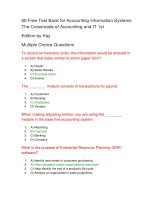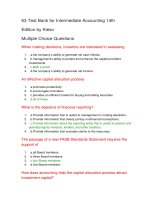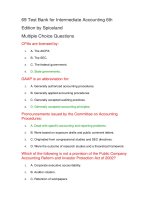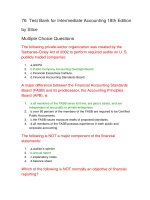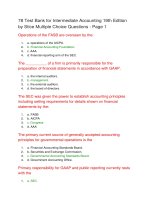79 test bank for intermediate accounting 17th
Bạn đang xem bản rút gọn của tài liệu. Xem và tải ngay bản đầy đủ của tài liệu tại đây (116.32 KB, 27 trang )
79 Test Bank for Intermediate Accounting 17th
Multiple Choice Questions-Page 1
The primary current source of generally accepted accounting principles for
governmental operations is the
1.
Financial Accounting Standards Board.
2.
Securities and Exchange Commission.
3.
Governmental Accounting Standards Board.
4.
Government Accounting Office.
Financial accounting is the area of accounting that emphasizes reporting to
1.
management.
2.
regulatory bodies.
3.
internal auditors.
4.
creditors and investors.
The Governmental Accounting Standards Board
1.
was incorporated into the Financial Accounting Standards Board when the FASB was
created.
2.
addresses financial reporting issues of U.S. government treaties and treasury rulings.
3.
addresses the financial reporting issues related to state and local governments.
4.
addresses the governmental reporting activities of the SEC.
The Journal of Accountancy is published by the
1.
American Accounting Association.
2.
American Institute of Certified Public Accountants.
3.
Financial Executives Institute.
4.
Financial Accounting Standards Board.
A conceptual framework of accounting should
1.
lead to uniformity of financial statements among companies within the same industry.
2.
eliminate alternative accounting principles and methods.
3.
guide the AICPA in developing generally accepted auditing standards.
4.
define the basic objectives, terms, and concepts of accounting.
Which is the correct historical sequence of accounting rule-making bodies?
1.
CAP, FASB, APB
2.
CAP, APB, FASB
3.
FASB, APB, CAP
4.
APB, CAP, FASB
Congress
1.
has legally barred the SEC from interfering with the work of the FASB.
2.
is restricted from holding hearings concerning the accounting profession.
3.
gave the SEC the power to establish accounting principles for corporations whose
stock is sold and traded to the general public.
4.
appoints two of the five members of the FASB.
When the FASB deliberates about an accounting standard, firms whose
financial statements would be affected by that standard
1.
are legally barred from lobbying the FASB.
2.
are not allowed to lobby the FASB if the standard would have a negative impact on
their financial statements.
3.
are not allowed to lobby the FASB if the standard would have a positive impact on their
financial statements.
4.
are free to lobby for or against the standard.
A major difference between the Financial Accounting Standards Board (FASB)
and its predecessor, the Accounting Principles Board (APB), is
1.
all members of the FASB serve full time, are paid a salary, and are independent of any
public or private enterprises.
2.
over 50 percent of the members of the FASB are required to be Certified Public
Accountants.
3.
the FASB issues exposure drafts of proposed standards.
4.
all members of the FASB possess experience in both public and corporate accounting.
Which of the following items is not a modifying convention?
1.
Matching
2.
Materiality
3.
Industry practices
4.
Conservatism
The primary purpose of the Securities and Exchange Commission is to
1.
regulate the issuance and trading of securities.
2.
issue accounting and auditing regulations for publicly held companies.
3.
prevent the trading of speculative securities.
4.
enforce generally accepted accounting principles.
Once the FASB has established an accounting standard, the
1.
standard is continually reviewed to see if modification is necessary.
2.
standard is not reviewed unless the SEC makes a complaint.
3.
task of reviewing the standard to see if modification is necessary is given to the AICPA.
4.
principle of consistency requires that no revisions ever be made to the standard.
Pronouncements issued by the SEC include
1.
Accounting Research Bulletins.
2.
Statements on Accounting Principles.
3.
Financial Accounting Standards.
4.
Financial Reporting Releases.
The responsibility to review the work of the accountants and issue opinions
as to the fairness of the financial statements rests with
1.
the external auditor.
2.
the board of directors.
3.
the internal auditors.
4.
management.
Generally accepted accounting principles
1.
are accounting adaptations based on the laws of economic science.
2.
derive their credibility and authority from legal rulings and court precedents.
3.
derive their credibility and authority from the federal government through the financial
reporting section of the SEC.
4.
derive their credibility and authority from general recognition and acceptance by the
accounting profession.
Proper application of accounting principles is most dependent upon the
1.
existence of specific guidelines.
2.
oversight of regulatory bodies.
3.
external audit function.
4.
professional judgment of the accountant.
Primary responsibility for the preparation of financial statements in
accordance with generally accepted accounting principles rests with
1.
the internal auditors.
2.
management.
3.
the external auditors.
4.
the board of directors.
The primary current source of generally accepted accounting principles for
nongovernmental operations is the
1.
American Institute of Certified Public Accountants.
2.
Securities and Exchange Commission.
3.
Financial Accounting Standards Board.
4.
Governmental Accounting Standards Board.
Management accounting is the area of accounting that emphasizes
1.
reporting financial information to external users.
2.
reporting to the SEC.
3.
combining accounting knowledge with an expertise in data processing.
4.
developing accounting information for use within a company.
Which of the following is not normally an objective of financial reporting?
1.
To provide information about an entity's assets and claims against those assets
2.
To provide information that is useful in assessing an entity's sources and uses of cash
3.
To provide information that is useful in lending and investing decisions
4.
To provide information about an entity's liquidation value
The overall objective of financial reporting is to provide information
1.
that is useful for decision making.
2.
about an enterprise's assets, liabilities, and owners' equity.
3.
about an enterprise's financial performance during a period.
4.
that allows owners to assess management's performance.
As independent (or external) auditors, CPAs are primarily responsible for
1.
preparing financial statements in conformity with GAAP.
2.
certifying the accuracy of financial statements.
3.
expressing an opinion as to the fairness of financial statements.
4.
filing financial statements with the SEC.
Form 10-K is submitted to the
1.
FASB.
2.
GASB.
3.
IRS.
4.
SEC.
Primary responsibility for GAAP and public reporting currently rests with the
1.
SEC.
2.
FASB.
3.
Congress.
4.
AICPA.
The normal order followed by the FASB in publishing its standards is
1.
statement, discussion memorandum, opinion.
2.
discussion memorandum, interpretation, exposure draft, statement.
3.
exposure draft, discussion memorandum, statement.
4.
discussion memorandum, exposure draft, statement.
The International Accounting Standards Board was formed to
1.
enforce FASB standards in foreign countries.
2.
develop worldwide accounting standards.
3.
establish accounting standards for U.S. multinational companies.
4.
develop accounting standards for countries that do not have their own standard-setting
bodies.
The responsibility of the Emerging Issues Task Force (EITF) is to
1.
issue statements which reflect a consensus of the EITF on how to account for new
financial reporting issues where guidance is needed quickly.
2.
do research on financial reporting issues that are being addressed by the AICPA.
3.
respond to groups lobbying the FASB on issues that affect a particular industry.
4.
develop concept statements the AICPA can use as a frame of reference to solve future
problems.
The Financial Accounting Foundation oversees the
1.
operations of the AICPA.
2.
operations of the FASB.
3.
AAA.
4.
financial reporting arm of the SEC.
The process of establishing financial accounting standards is
1.
a democratic process in that a majority of practicing accountants must agree with a
standard before it becomes implemented.
2.
a legislative process based on rules promulgated by government agencies.
3.
based solely on economic analysis of the effects each standard will have if it is
implemented.
4.
a social process which incorporates political actions of various interested user groups
as well as professional research and logic.
Documents issued by the FASB include all of the following except
1.
Statements of Financial Accounting Standards.
2.
Interpretations of Statements of Financial Accounting Standards.
3.
Statements of Financial Accounting Concepts.
4.
Financial Reporting Releases.
How many board members serve on the FASB?
1.
5
2.
7
3.
14
4.
20
Which of the following is a characteristic of the Financial Accounting
Standards Board?
1.
The FASB is composed of five members.
2.
FASB members must come from CPA firms.
3.
FASB members are part-time.
4.
FASB members may retain their positions with previous employers.
Members of the Financial Accounting Standards Board are appointed by the
1.
American Accounting Association.
2.
Financial Accounting Foundation.
3.
Securities and Exchange Commission.
4.
American Institute of Certified Public Accountants.
Prior to 1973, generally accepted accounting principles were established
1.
by the Financial Accounting Foundation.
2.
by the Securities and Exchange Commission.
3.
under the direction of the American Institute of Certified Public Accountants.
4.
by the individual states.
Which of the following is an internal user of a company's financial
information?
1.
Board of directors
2.
Stockholders in the company
3.
Holders of the company's bonds
4.
Creditors with long-term contracts with the company
71 Free Test Bank for Intermediate Accounting 17th
Edition by Stice Multiple Choice Questions-Page 2
The assumed continuation of a business entity in the absence of evidence to
the contrary is an example of the accounting concept of
1.
accrual.
2.
consistency.
3.
comparability.
4.
going concern.
Which of the following is true about international accounting standards?
1.
Significant differences exist between U.S. GAAP and GAAP of other countries.
2.
Few differences exist between U.S. GAAP and GAAP of other countries.
3.
The IASB is the standards-setting body of France.
4.
It is unlikely that the differences between U.S. GAAP and GAAP of other countries will
diminish over time.
When financial reports from two different companies have been prepared and
presented in a similar manner, the information exhibits the characteristic of
1.
relevance.
2.
reliability.
3.
comparability.
4.
consistency.
Historical cost has been the valuation basis most commonly used in
accounting because of its
1.
timelessness.
2.
conservatism.
3.
reliability.
4.
accuracy.
Accounting for inventories by applying the lower-of-cost-or-market is an
example of the application of
1.
conservatism.
2.
comparability.
3.
consistency.
4.
materiality.
Accountants prepare financial statements at arbitrary points in time during a
company's lifetime in accordance with the accounting concept of
1.
matching.
2.
comparability.
3.
accounting periods.
4.
materiality.
Which of the following is not an implication of the going-concern
assumption?
1.
The historical cost principle is credible.
2.
Depreciation and amortization policies are justifiable and appropriate.
3.
The current/noncurrent classification of assets and liabilities is justifiable and
significant.
4.
Amortizing research and development costs over multiple periods is justifiable and
appropriate.
The secondary qualitative characteristics of accounting information are
1.
relevance and reliability.
2.
comparability and consistency.
3.
understandability and decision usefulness.
4.
materiality and conservatism.
Financial statements issued for the use of parties external to the enterprise
are the primary responsibility of the
1.
management of the enterprise.
2.
stockholders of the enterprise.
3.
independent auditors of the enterprise.
4.
creditors of the enterprise.
Recording the purchase price of a pencil sharpener (with an estimated useful
life of 10 years) as an expense of the current period is justified by the
1.
going-concern assumption.
2.
materiality constraint.
3.
matching principle.
4.
comparability principle.
The United States Securities and Exchange Commission
1.
has recognized IASB standards as an acceptable alternative to U.S. GAAP.
2.
requires foreign companies listing their shares on U.S. stock exchanges to restate their
financial statements to U.S. GAAP.
3.
has barred foreign companies from listing their shares on U.S. stock exchanges.
4.
has no jurisdiction in the United States over foreign companies listing their shares on
U.S. stock exchanges.
Which of the following elements of financial statements is not a component of
comprehensive income?
1.
Revenues
2.
Expenses
3.
Losses
4.
Distributions to owners
Which of the following is not included in the highest authoritative level of
GAAP?
1.
FASB Statements
2.
AICPA Statements of Position
3.
FASB Staff Positions
4.
Accounting Principles Board (APB) Opinions
The financial statements that are prepared for the business are separate and
distinct from the owners according to the
1.
going-concern assumption.
2.
matching principle.
3.
economic entity assumption.
4.
full disclosure principle.
Which of the following is true?
1.
Form 10-K is required under the FASB Conceptual Framework.
2.
Form 10-Q is a quarterly report of significant events required by the SEC.
3.
Form 8-K is a quarterly report of significant events required by the SEC.
4.
Form 8-K is the annual report submitted by small businesses to the SEC.
The accrual basis of accounting is based primarily on
1.
conservatism and revenue realization.
2.
conservatism and matching.
3.
consistency and matching.
4.
revenue realization and matching.
The journal Accounting Horizons is published by which of the following
organizations?
1.
American Institute of Certified Public Accountants (AICPA)
2.
American Accounting Association (AAA)
3.
Securities and Exchange Commission (SEC)
4.
Financial Accounting Standards Board (FASB)
Which of the following qualitative characteristics of financial information
requires that information not be biased in favor of one group of users to the
detriment of others?
1.
Relevance
2.
Reliability
3.
Verifiability
4.
Neutrality
Conservatism is best described as selecting an accounting alternative that
1.
understates assets and/or net income.
2.
has the least favorable impact on owners' equity.
3.
overstates, as opposed to understates, liabilities.
4.
is least likely to mislead users of financial information.
Which of the following is not a purpose of the conceptual framework of
accounting?
1.
To provide definitions of key terms and fundamental concepts
2.
To provide specific guidelines for resolving situations not covered by existing
accounting standards
3.
To assist accountants and others in selecting among alternative accounting and
reporting methods
4.
To assist the FASB in the standard-setting process
The primary measurement basis currently used to value assets in external
financial statements of an enterprise is the
1.
current market price if the assets currently held by an enterprise were sold on the open
market.
2.
current market price if the assets held by an enterprise were purchased on the open
market.
3.
present value of the cash flows the assets are expected to generate over their
remaining useful lives.
4.
market price of the assets held by an enterprise at the date the assets were acquired
(although some assets may be valued at their current selling price or net realizable
value).
Disclosure requirements for financial reporting are strictest in
1.
the United Kingdom.
2.
Germany.
3.
the United States.
4.
France.
Which of the following measurement attributes is not currently used in
practice?
1.
Present value
2.
Net realizable value
3.
Current replacement cost
4.
Inflation-adjusted cost
For which of the following reporting issues has the FASB adopted
substantially the same approach as the IASB?
1.
Segment reporting
2.
Earnings per share
3.
Statement of cash flows
4.
Pension plans
Which of the following statements concerning the objectives of financial
reporting is correct?
1.
The objectives are intended to be specific in nature.
2.
The objectives are directed primarily toward the needs of internal users of accounting
information.
3.
The objectives were the end result of the FASB's conceptual framework project.
4.
The objectives encompass not only financial statement disclosures, but other
information as well.
Which of the following is not one of the fundamental criteria for recognition?
1.
Timeliness
2.
Measurability
3.
Relevance
4.
Reliability
An item would be considered material and therefore would be disclosed in the
financial statements if the
1.
expected benefits of disclosure exceed the additional costs.
2.
impact on earnings is greater than 3 percent.
3.
FASB definition of materiality is met.
4.
omission of misstatement of the amount would make a difference to the users.
The singularly unique function performed by certified public accountants in
United States is
1.
tax preparation.
2.
management advisory services.
3.
the attest function.
4.
the preparation of financial statements.
What accounting concept justifies the use of accruals and deferrals?
1.
Going-concern assumption
2.
Corporate form of organization
3.
Consistency characteristic
4.
Arm's-length transactions
Financial information exhibits the characteristic of consistency when
1.
accounting procedures are adopted which smooth net income and make results
consistent between years.
2.
extraordinary gains and losses are shown separately on the income statement.
3.
accounting entities give similar events the same accounting treatment each period.
4.
expenditures are reported as expenses and netted against revenue in the period in
which they are paid.
The branch of accounting that is concerned primarily with providing
information for internal users is called
1.
auditing.
2.
managerial accounting.
3.
financial accounting.
4.
income tax accounting.
According to the FASB's conceptual framework, the process of reporting an
item in the financial statements of an entity is
1.
realization.
2.
recognition.
3.
matching.
4.
allocation.
When a large number of individuals, using the same measurement method,
demonstrate that a high degree of consensus can be secured among
independent measurers, then the result exhibits the characteristic of
1.
verifiability.
2.
neutrality.
3.
relevance.
4.
reliability.
The overriding qualitative characteristic of accounting information is
1.
relevance.
2.
understandability.
3.
reliability.
4.
decision usefulness.
The branch of accounting that is concerned with providing information to
present and potential creditors of an enterprise is
1.
auditing.
2.
managerial accounting.
3.
financial accounting.
4.
income tax accounting.
Important constraints underlying the qualitative characteristics of accounting
information are
1.
historical cost and going concern.
2.
materiality, conservatism, and cost-effectiveness.
3.
consistency, comparability, and conservatism.
4.
verifiability, neutrality, and representational faithfulness.
Free Text Questions
Many accountants argue that relevance and reliability often require trade-offs.
Define both relevance and reliability and explain what is meant by "trade-offs"
between relevance and reliability. Include in your explanation a specific
example of where trade-offs could occur.
Answer Given
Relevance is the capacity of information to make a difference in a decision by helping
users form predictions about the outcome of past, present, and future events or to
confirm or correct prior expectations. Reliability is the quality of information that
assures that information is reasonably free from error and bias and faithfully
represents what it purports to represent.Accounting information must be both relevant
and reliable to be useful to decision makers. Attributes relevant to a user's decision
process may not always be susceptible to reliable measurement.For most entities, the
use of only cash sales would provide reliable data. Failure to include credit sales,
however, makes the revenue figure less relevant than it could be in assessing the
entity’s financial health. A revenue measure that includes orders for future delivery
may be relevant but is less reliable because these future orders may be canceled.
Similarly, the current value of the intellectual assets of a high technology company
clearly is relevant to many decisions relating to the company. No reliable means of
establishing these values may exist, however.Emphasizing reliability results in long
preparation times as information is double-checked. Estimates and forecasts that
cloud data with uncertainty are avoided. Relevance, on the other hand, often requires
the use of instant information full of uncertainty.
Users require a variety of information about the financial position and
performance of a firm in order to make decisions. Users cannot wait until the
life of the business is completed. Accordingly, the accounting period
assumption requires that financial reports depicting changes in wealth of an
enterprise be prepared periodically.Required: Explain the relationship
between the accounting period assumption and accrual basis accounting.
Answer Given
The accounting period assumption states that an enterprise should provide periodic,
short-term financial reports, thus requiring the use of accruals and deferrals in order to
identify revenues, expenses, gains, and losses with specific time periods. The use of
accruals and deferrals represents the primary difference between the accrual basis of
accounting and the cash basis of accounting. Under the accrual basis of accounting,
revenues are recognized when earned (not when cash is received) and expenses are
recognized when incurred (not when cash is disbursed). Each period, accruals and
deferrals are used for items such as prepaid expenses, uncollected revenues, unpaid
wages, and depreciation expense. The use of accruals requires that judgments and
estimates be made, rendering financial reports more arbitrary and imprecise. These
drawbacks are offset by the significance of periodic financial report to users in making
decisions.
In Statement of Financial Accounting Concepts No. 1, “Objectives of Financial
Reporting by Business Enterprises,” the Financial Accounting Standards
Board presents the objectives of financial reporting. Required:Identify the
three major objectives of financial reporting and explain the interrelationships
that exist between these objectives.
Answer Given
The three major objectives of financial reporting are:1.To provide information useful in
investment, credit, and similar decisions. 2.To provide information useful in assessing
the amounts and timing of cash flows. 3.To provide information about enterprise
resources, claims to those resources, and changes in them. The first objective is the
most general and states that financial information must be useful in making decisions.
The two subsequent objectives are progressively narrower in scope.The second
objective indicates that in order to be useful, information provided must assist users in
determining the probability of receiving cash flows from the enterprise and the
amounts and timing of these cash flows.The third objective identifies the general
nature of the information needed by users in assessing the prospects of cash flows
occurring.
The going-concern assumption holds that the business entity will continue its
operations long enough to realize its projects, commitments, and ongoing
activities. The assumption is that the entity is not expected to be liquidated in
the foreseeable future or that the entity will continue for an indefinite period of
time.Explain the relationship between the going-concern assumption and the
historical cost principle and the amortization of assets.
Answer Given
The going-concern assumption justifies the valuation of assets on a nonliquidation
basis. The assumption that the entity will continue its operations long enough to realize
its projects, commitments, and activities renders liquidation values irrelevant since
assets typically will be held and not sold in the foreseeable future. Fixed assets and
intangibles thus are amortized over their useful life rather than over a shorter period in
anticipation of early liquidation.
The mission statement of the Financial Accounting Standards Board includes
a goal of promoting international comparability of accounting standards.
Furthermore, the International Accounting Standards Board has begun over
the last 20 years to issue international accounting standards designed to
create a common set of international accounting and reporting
standards.Identify reasons why such a set of international accounting
standards would be desirable.
Answer Given
A common set of international accounting standards would enhance the comparability
of the financial information produced by enterprises in countries throughout the world.
Comparability would allow United States and foreign companies to better assess their
position relative to their competitors. Comparability also would facilitate the
management of relationships with customers, suppliers, and others throughout the
world. Additionally, comparability would ease the process of raising capital or investing
in foreign securities. Foreign companies wishing to list their equity securities on the
New York Stock Exchange, for example, must convert their financial statements and
accompanying notes to U.S. generally accepted accounting principles. This can be a
very costly and time-consuming process. International accounting standards accepted
in all countries could eliminate the cost of such a conversion and speed the process of
raising capital.
The harmonization of world accounting standards is viewed by many
accountants, analysts, standard setters, and others as being among the most
important issues facing business throughout the world. Advocates of
harmonization seek to establish a common set of international accounting
and reporting standards. Such a task has proven formidable, however.Identify
factors that would hinder the process of harmonization of accounting
standards.
Answer Given
Accounting standards throughout the world exhibit a great breadth of scope,
complexity, and rigidity. Some countries currently have in place standards that are
relatively weak when compared with those of the United States, for example. The
United States typically is viewed as having the most highly developed and rigid
accounting standards in the world. The rigidity, completeness, and complexity of U.S.
standards is due in no small part to the role of the Securities and Exchange
Commission (SEC). The SEC is a government agency that has the right (granted to it
by the United States Congress) to set accounting standards in the United States, but
has delegated this standards setting process to the private sector. This does not
mean, however, that the SEC is not involved in the process of standard setting.The
SEC assumes an active role in the establishment of accounting standards. Any set of
international accounting standards must be accepted by the SEC if such standards are
to be allowed for non-U.S. companies seeking to sell securities in U.S. capital markets.



